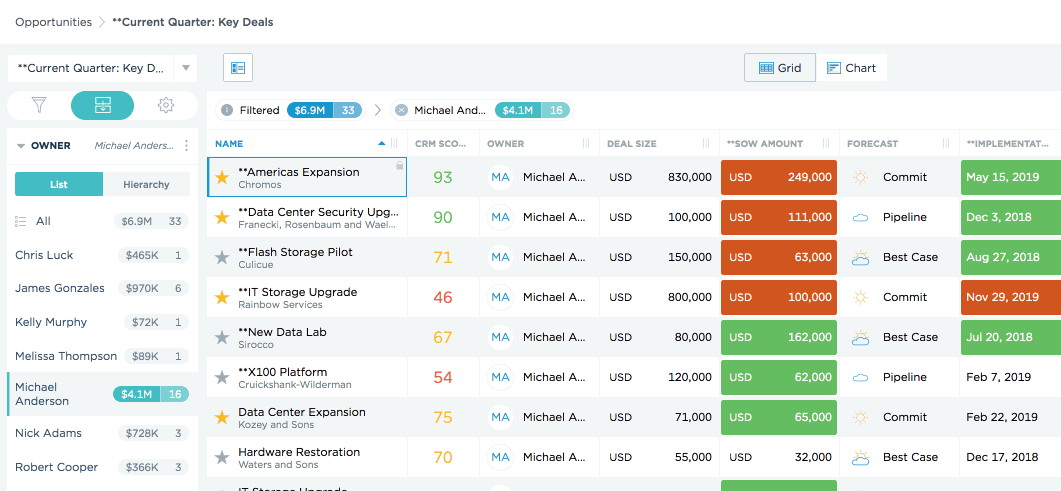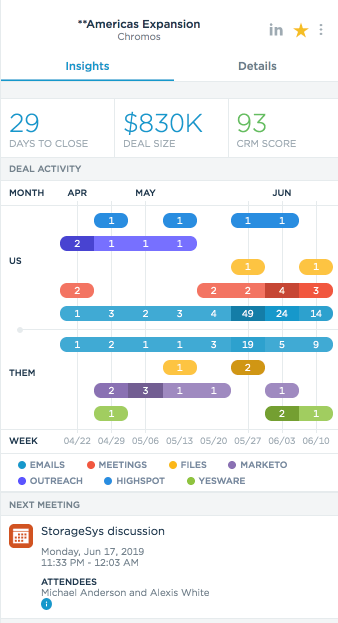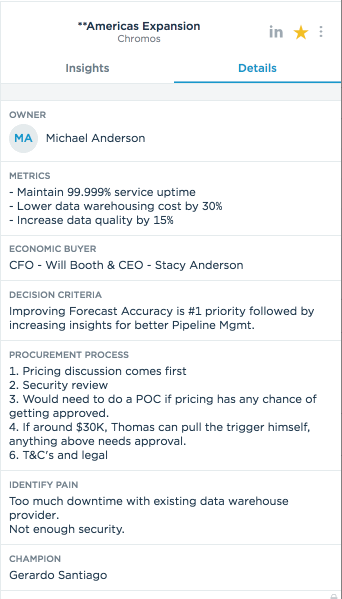Sales is often the most expensive department in a company, but also frequently the most inefficient. As profit margins are getting squeezed across industries, sales leaders are under pressure to motivate every rep to achieve like high-performing superstars. For that, one-on-one coaching stands among the top tactics to provide reps with a consistent opportunity to help grow their career and strategize on their deals.
The one-on-one meeting is, in theory, a rare opportunity for sales reps to get their managers’ undivided attention, free from the distractions, competing goals or hurried dynamics of group meetings. However, in the busy world of B2B selling, that’s often not the case.
A Harvard Business Review study of Fortune 500 companies found that direct reports rank their sales leaders at 38% for effectiveness. In another study, 60% of reps said they’d leave a company if their manager wasn’t a good sales coach. That means moves like one-on-one meetings can help keep your staff engaged in their work and motivated to sell. Done right, these meetings also offer you detailed insight into your team and their sales so you can build a more accurate big picture.
In this definitive guide for high-growth sales leaders, learn how to lead productive, effective one-on-ones with your reps. Mastering the one-on-one sales meeting will ultimately motivate your reps, improve their performance, and supercharge sales for the entire organization.
What Is a One-on-One Sales Meeting?
The one-on-one is one of the most important components of your sales operating process, impacting sales execution and, ultimately, revenue. These meetings are your moment to strategize sales execution privately with each rep, overcome roadblocks together, and give them a motivational boost. In the ideal one-on-one, the manager coaches the rep on risk mitigation, sales pipeline acceleration and deal execution.
The one-on-one is a prime opportunity to focus your rep on the deals that need their attention, so they don’t waste time sharing status updates on deals that are already in a good place. This is your chance to develop an action plan together.
“Reps crave coaching,” says Alex Kremer, sales manager at Outreach. “They want to know how to close better. They want to know how to demo better. They want to learn how to ask better and stronger open-ended questions.”
Where Do Sales One-on-Ones Go Wrong?
Before we dive into preparation tips and the ideal one-on-one meeting template, let’s explore the most common pitfalls. Keep in mind, ineffective one-on-ones create an ugly cycle. Once your reps develop a distaste for these meetings, they lose confidence in the process and begin to dread future one-on-one meetings. They may detach or become defensive about their performance, instead of trying to improve. If you see yourself or other sales leaders making these mistakes, it’s time to make changes, pronto.
Mistake #1: Your one-on-ones resemble interrogations rather than a collaborative session.
Spending your time on a fact-finding mission doesn’t help close deals. Oftentimes, cross-examining your rep for status updates on each and every open opportunity is so time-consuming, you run out of time to discuss the deals that need the most attention.
Mistake #2: You lack updated, accurate data.
Most sales managers lack visibility into sales pipeline health and rep activity, which explains why they come with more questions than answers. Without up-to-date deal data, you’re forced to retrace steps and fill in the gaps any way you can. But here’s the thing: Reps don’t have time to input data into CRM. It’s a manual, painstaking process that takes them away from selling. Luckily, tracking sales activity data can be automated.
Mistake #3: You ask generic, unfocused questions.
When a sales leader asks a generic question like, “What’s on your mind?” or “How’s it going?,” or “Tell me about deals A, B, C,” it shows the rep their manager hasn’t prepared, or doesn’t have proper insight into your deals to ask the right questions. They’re starting with a blank slate, as if they’ve never interacted with that sales rep before. Granted, building rapport is important, but productive sales one-on-ones need focused discussion on sales execution strategy.
Mistake #4: You don’t follow up.
When sales managers don’t follow up on the rep’s commitments from the last one-on-one, they’re not holding their reps accountable. It’s another sign they were simply going through the motions and not paying attention. Do you have a single source of truth shared between manager and rep that can be used as reference?
Mistake #5: You’re not consistently meeting one-on-one.
As Grace Tyson, sales manager at Chorus, shares, only 47% of managers are coaching their reps for more than 30 minutes a week. Every company has their own cadence for one-on-one meetings, but at a minimum, weekly check-ins are critical. At Outreach, Kremer says the sales teams have weekly sales pipeline reviews, biweekly coaching calls, and regular mentorship meetups.
Sales Manager, Sales Coach: The New Approach to Sales Leadership
There’s a difference between giving your reps instructions and supporting them in a way that helps them discover the answers. In the era of disruption, managers don’t have all the answers — which is why more companies are shifting to coaching as the new approach to leadership, according to Harvard Business Review. Sir John Whitmore, a pioneer in the executive coaching industry, once described skilled coaching as “unlocking people’s potential to maximize their own performance.”
There’s plenty of evidence that effective coaching makes a difference in sales performance and revenue growth:
- Salespeople who received quality coaching saw a 19% improvement in long-term performance, according to the Sales Executive Council.
- Companies that invest in sales coaching generate, on average, 16.7% greater annual revenue growth, according to the Sales Management Association.
The one-on-one sales meeting isn’t all about making your reps work harder. It’s about cultivating a strong mindset that elevates the entire organization. Through quality coaching focused on deals and sales performance, you inspire your reps to feel a sense of agency. Your sales reps should feel as though they’re on a bigger mission than hitting their numbers. The one-on-one is a valuable career development opportunity for the rep.
“I always try to make sure my reps go back to their desks feeling stronger than they did before our one-on-one,” says Kremer, sales manager at Outreach.
What can managers do to be better sales coaches during the one-on-one? It starts with preparation.
How to Prepare Effective Sales One-on-Ones with 4-Point Deal Inspection
Your time and your rep’s time are extremely valuable. Meetings are time spent away from prospects. To ensure your meeting is as efficient as possible, prepare for your one-on-one meetings by inspecting sales pipeline health and checking on deal progress beforehand. Look for the story the numbers tell: What are the trends? What are successes? Where are the risks?
You’ll never have time to hit every deal in one meeting, so skip the sure wins and flag the deals that are at risk. Performing this 4-point deal inspection before your one-on-one will allow you do to this by identifying where you and your rep need to spend the most time. XXXX
The 4-Point Deal Inspection
#1: What changed in this deal? Deals are dynamic — they’re changing every day, sometimes every hour.
- Has the dollar amount changed?
- Has the close date changed?
- Has the forecast category been updated?

Answering these questions will tell you if a deal needs your attention or not. If the changes are positive, you can potentially skip these and focus on where more negative changes have occurred.
#2: How likely is this deal to close? Review historical data regarding past closed won and closed loss deals.
- Did the rep recently move the deal from Best Case to Commit?
- How long has the deal stayed in a given stage?
- What do these metrics tell us given historic conversion rates?
- Have similar deals moved through the sales process with ease or is this behavior a red flag?

These calculations aren’t easy to make, but new artificial intelligence tools can provide these insights in real-time.
#3: How much activity do we have on this deal? To properly inspect the health of a deal, check how engaged the prospect is with the sales rep.
- How many emails, calls, and meetings has the rep had with the prospect?
- When is the next meeting?
- With whom is the rep engaging?
- Has the rep sent the contract to the prospect yet?

Ideally all of this data lives in CRM, but we all know that typically doesn’t happen. Reps don’t have time to undertake this manual and time consuming process. Here are a few solutions to the challenge of tracking sales activity.
#4: Is this deal following our sales process? You need to make sure your rep is doing their due diligence and capturing the relevant information.
- Is the deal in the right place to close based on our sales methodologies (e.g., MEDDIC, BANT, SPIN, Challenger, Sandler, etc.)?
- Is every field filled out, signalling a viable opportunity?
- If not, what are the steps we need to take to get the right information?

All of these steps require a significant amount of data that is easily surfaced in one dashboard. Ideally both the rep and manager can go through this single source of truth to identify where there is risk in the deal and next steps.
The Step-by-Step Guide to Running Your Most Productive Sales One-on-One
Now that you know which deals need strategizing, what the critical updates are, and what issues need further discussion, you’re ready to lead your one-on-one meeting with your sales rep. Follow this meeting template and start boosting sales performance.
Step #1: Start with a big picture view on performance.
Guide your rep through a brief, 5- to 10-minute overview of their progress to date and highlight key performance indicators for the quarter. That includes closed deals, open pipeline, new pipeline creation, recent activity, and number of overdue deals. Review the commitments your rep made on the last one-on-one and discuss their progress. By reviewing the right KPIs together, you’re getting on the same page and framing the rep’s performance objectively.
“One of the hardest parts of any sales manager’s job is to discuss performance issues with a rep. But it’s also one of the most important,” says Grace Tyson, sales manager at Chorus. “To ensure that emotions and finger-pointing stay out of the discussion, it’s absolutely critical that the manager focus on the data.”
Step #2: Dive deep together into the deals that you’ve identified as at-risk.
What factors make these deals risky? What can we do to reduce risk and move closer to closing? This is your opportunity to go deep.
Coaching requires understanding your rep’s perspective better, so that you can guide them more effectively. They may have questions, roadblocks, or insights they need to share. Walk through scenarios and options, and strategize on a plan.
If a deal slipped to the next quarter, for example, figure out your next play to possibly bring those deals in early next quarter.
To make the most of your one-on-one time, follow a consistent framework so your sales rep knows what to expect and can prepare accordingly. At Chorus, Tyson says the one-on-one agenda covers opportunity creation, pipeline value, lost deals, the reasons why deals are lost, and activity metrics. The one-on-ones also cover leading indicators of success, like talk-time ratio on calls and engaging questions.
Rely on data to guide the discussion. For example, Tyson says that listening to call recordings with your rep can help you approach the topic objectively: “Last week we agreed that the call should include a discussion of X. But what happened was Y.” In this type of scenario, Tyson recommends getting your rep’s perspective on why that occurred, then offer your perspective — again, based purely on data and actions. Then tie the impact of Y to specific outcomes and collaborate on how to fix the situation.
Step #3: Drive deal strategy from a macro perspective.
While the deep dive helps you iron out the details, driving deal strategy involves asking a different set of questions from a big picture view. Rookies and seasoned sales reps alike need to be able to zoom out to come up with creative strategies.
For example, an effective deal strategy might require bringing in other people, like C-level executives, to manage the deal. Jake Mars, VP for North America sales at Alteryx, describes the scenario.
“A rep may have sales alignment with the company’s CIO, but in order to close the deal, they may still need to align each team’s CFO,” he says. “That sequence of events could be critical in progressing the deal, and the rep may not be in a position to achieve it on their own. As leaders, don’t just be available to support a deal, actively encourage your reps to include you in plays they cannot complete on their own.”
A sales rep might resist giving up ownership of a deal. But with the right coaching, your rep might even be the one to propose this solution the next time a similar scenario comes up.
Step #4: Evaluate the forecast and identify any gaps to hitting your numbers.
Now that you and your rep have a clear view of which deals are healthy and which need work, you can call your sales forecast far more accurately. You’re both in the right headspace to look toward the future:
- What number your rep is calling
- How much revenue have they closed against their quota
- How much revenue have they closed against their forecast.
At this point, evaluate whether your rep has enough pipeline coverage to hit their number.
Focus on key opportunities and provide strategic guidance and coaching to make sure deals are actively progressing towards close. Because you dedicated most of the meeting to at-risk deals, this is a good time to look at the strong deals and strategize how to accelerate those.
Keep an eye out for any bits of information you could use for coaching, including what needs improvement and what deserves praise. Point out your rep’s specific actions that might’ve led to a win — no matter how small.
“Sometimes the best performers have trouble identifying the specific reasons why they are successful, so this is an area where you can add immense value,” Tyson says.
Step #5: Agree on next steps.
Accountability is gold. Wrap up by recapping the rep’s action plan and resolving any questions about those next steps. Even better, put those action items in writing with agreed-upon deadlines.
However, avoid giving the rep too much to do. A long to-do list could overwhelm your rep, which could lead to procrastination, dread, or pure avoidance.
“If you give your rep five or six items that they need to work on, at the end of the day they're not going to do any of it,” Kremer says. “So be very prescriptive and specific in one thing to work on. Once they prove that they've mastered it, you can move on.”
The objective isn’t solely to cross off the items on the list. Keep your focus on the end goals and know how those action items will get you there.
How Clari Can Supercharge Your One-on-One Sales Meetings
Your one-on-one meetings with your sales reps have the potential to radically uplevel your team’s sales skills and output. Your one-on-one time is too valuable to waste retracing your rep’s steps or filling in gaps. Imagine skipping the tedious interrogation questions: “Did you send the email?” “Did you make the phone call?” “Has the contract been sent?” “With whom have you spoken?”
With Clari, you can access that critical data immediately, at a glance. Clari automatically tracks critical sales activity data from a variety of systems, including email, calendar, sales enablement tools and more, so reps don’t have to manually add it to the CRM.
This data is then visualized in a single pane for reps and managers, giving you the power to inspect the health of every deal. Clari also automatically updates and color-codes changes to specific fields — like deal size, rep forecast, and close date — in CRM so you know exactly what is happening in real time.
For Clari’s customers, one-on-ones will never be the same.
“With Clari, the narrative on sales calls has switched from ‘What the hell happened?’ to ‘What’s going to happen?’” says Yamini Rangan, chief customer officer at Hubspot.
Instant, AI-powered insights from Clari allow sales leaders to dedicate their limited one-on-one coaching time on the opportunities that matter most. Clari even generates an AI-driven CRM Score to clue you in when a deal may be at risk, so you know exactly when and where to provide that critical extra guidance. With Clari, you get real-time visibility into sales pipeline health, deals, and overall trends, so you can make the most of your one-on-one time. You can continue asking questions to help you plan a productive one-on-one.
Need more hands-on assistance? Reach out to the Clari team today and learn how to maximize your one-on-ones or take a look at more Clari content:



